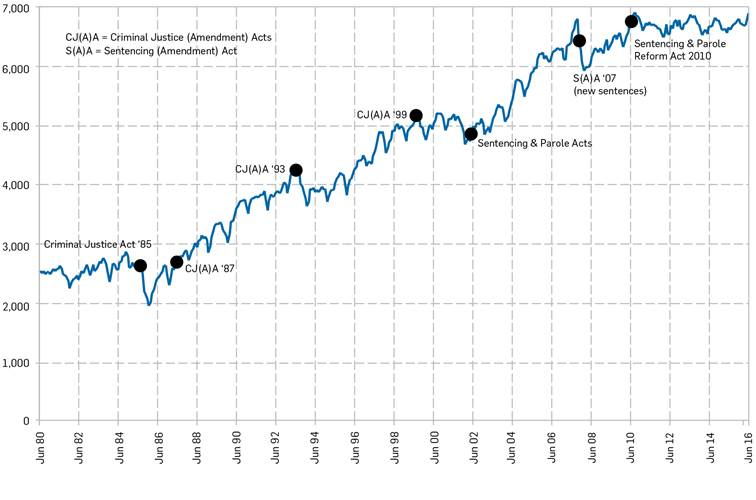In February 2018, the prison population was rising so fast there were only 300 beds left in the entire prison estate. National was planning to build a new mega prison at Waikeria. As at December 2020, the prison population has dropped to 8,521 and a new prison was not required. Here’s why the prison muster dropped. However, this reduction is not likely to last. Now that the Labour Party, under Jacinda Ardern, has an outright majority, we need some strategies which are easy to implement and which will substantially cut the prison population within the next three to six years. Here’s why.
1) New Zealand’s short electoral cycle:

Given that New Zealand has a three-year electoral cycle, the 15-year time span proposed by Labour to cut the prison muster is totally unrealistic. Governments are often in power for six years, occasionally for nine.
Given the intense competition between National and Labour over the last 25 years to be ‘tough on crime’, it seems highly unlikely there will ever be cross-party agreement on measures to reduce the prison population.
Although Bill English famously declared in 2011 that prisons were a fiscal and moral failure, National’s response has always been predictable – just lock up the bad guys and, if necessary, build more prisons.
The Labour-led Government doesn’t have 15 years to get on top of the problem.
The reality is that the Labour Government will probably have to sort this out by itself. This means it doesn’t have 15 years to get on top of the problem – it only has three, six, or nine if it’s lucky.
The solutions proposed on this website are so straight forward, they are guaranteed to bring the prison population down.
2) The prison muster is out of control:
For 25 years, competition between Labour and National to be tough on crime focussed primarily on what crimes, and for how long, offenders are sentenced to prison. The graph below shows the impact of legislative changes on the sentenced prison population between 1985 and 2016. Each new punitive piece of legislation has led to a steady increase in the number of long term prisoners over this period.
The sentenced prisoner population 1980-2016 linked to key legislative changes
It was not until 2013 that National began targeting remand prisoners as well as sentenced prisoners. In response to media outrage at the murder of Christie Marceau, National passed the Bail Amendment Act making it much tougher for defendants to be granted bail. The Act was only intended to keep people charged with serious violent crimes from being bailed. Projections by the Ministry of Justice claimed the new Bill would increase the number of prisoners on remand by less than 60. But that’s not what happened. Three years later, there were 1,500 new remand prisoners (see graph below) – exactly the same number as the capacity of the new prison planned for Waikeria.
 Graph shows the dramatic increase in remand population above justice sector forecasts after the Bail Amendment Act was introduced in 2013.
 3) The rising cost of the prison system is totally unsustainable:
3) The rising cost of the prison system is totally unsustainable:
Under Helen Clark, the Labour Government built four new prisons. In 2011, National built a new one to replace the aging Mt Eden prison and another one is planned at Waikeria. One thing is certain. If that new prison is built, it will fill up.
Prisons are expensive to build and to run. Each inmate costs the taxpayer about $100,000 per annum. Because the muster keeps rising, so does the cost to the taxpayer. In 2017, the Corrections Department’s operating costs were just over $1.6 billion.  On top of this, the estimated cost of the new prison is between $1 billion and $2.5 billion over the next five years.
The Corrections Department employs over 8,500 staff and has become the biggest Government Department in the country.Â
As the muster mushrooms, so does the size of the Corrections Department. It now employs over 8,500 staff and has become the biggest Government Department in the country. In other words the Government puts more resources into locking Kiwis up, and managing offenders in the community, than it puts into any other economic activity. In a country rated the second most peaceful in the world, that doesn’t make sense, let alone economic sense. The billions spent on prisons are no longer available for education, health, addiction treatment, mental health treatment or infrastructure where additional funding is really needed. New Zealand needs to reprioritise this prison spending and use the funding in more constructive ways. But this will require a Government willing to ignore the fear mongering of the lock ‘em up brigade and the political pressures of penal populism.
Conclusion
The prison muster has dropped significantly in the last three years, assisted by the coronavirus lockdown in 2020. But the lockdown is over and judges are still compelled by the Bail Amendment Act to place more and more offenders into prison on remand. This website describes four simple strategies that will reduce the numbers on remand and the number of sentenced prisoners by between 3,000 and 4,000 in six years.

